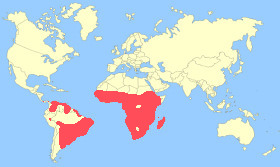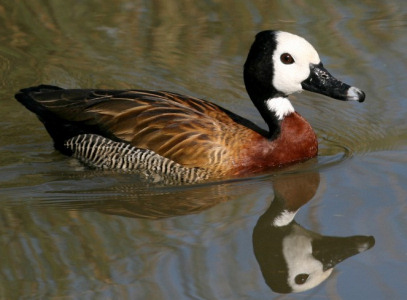Appearance: - The White-faced Whistling Duck has a white face and crown, a black nape and upper neck with a white spot on the throat, a rich chestnut brown lower neck, breast, and back, barred black and white flanks, and the rump, tail underparts, and underside of wings are black. The beak is dark grey or black, and its legs are dark bluish-grey. Both sexes are similar.
Size: - Typical Adult is 41-46cm (16-18in).
Food: - Mainly aquatic vegetation, seeds, grasses, weeds and small aquatic animals.
Habitat/Range: - Wetlands, freshwater lakes, and reservoirs in south America, and Africa - south of the Sahara.

 Breeding Habitat/Resident,
Breeding Habitat/Resident,  Migration or Winter Area.
Migration or Winter Area.Breeding Season: - August to October in Trinidad.
Eggs: - 8 to 12 (creamy-white colour with pinkish tinge).
Notes: - The White-faced Whistling Duck is also sometimes called the White-faced Tree Duck. This duck is a good swimmer and diver but does not readily perch but rests during the day on sandbanks or islands and feeds during the night. As with other Whistling Ducks, this is a noisy duck with a clear three-note whistling call.
Conservation status (IUCN 3.1):
Least Concern.
Classification: - Family: Anatidae,
Subfamily: Dendrocygninae,
Genus: Dendrocygna.





























